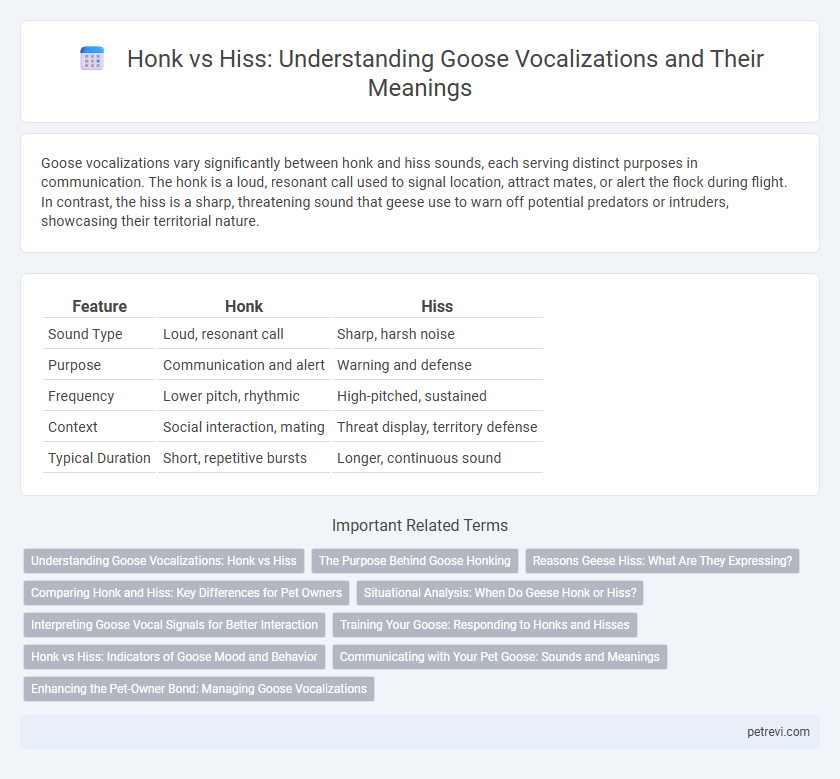Goose vocalizations vary significantly between honk and hiss sounds, each serving distinct purposes in communication. The honk is a loud, resonant call used to signal location, attract mates, or alert the flock during flight. In contrast, the hiss is a sharp, threatening sound that geese use to warn off potential predators or intruders, showcasing their territorial nature.
Table of Comparison
| Feature | Honk | Hiss |
|---|---|---|
| Sound Type | Loud, resonant call | Sharp, harsh noise |
| Purpose | Communication and alert | Warning and defense |
| Frequency | Lower pitch, rhythmic | High-pitched, sustained |
| Context | Social interaction, mating | Threat display, territory defense |
| Typical Duration | Short, repetitive bursts | Longer, continuous sound |
Understanding Goose Vocalizations: Honk vs Hiss
Goose vocalizations primarily consist of honks and hisses, each serving distinct communication functions. Honks are loud, repetitive calls used to signal alarm, maintain flock cohesion, or assert territory, while hisses are softer, threatening sounds that typically indicate a defensive or warning behavior. Understanding the difference between honk and hiss vocalizations is crucial for interpreting goose behavior and their response to environmental stimuli.
The Purpose Behind Goose Honking
Goose honking primarily serves as a long-distance communication tool to maintain flock cohesion during flight and alert others to potential threats. This vocalization is characterized by loud, clear sounds that carry over great distances, contrasting with the softer, more aggressive hiss used to deter predators or intruders nearby. The honk's purpose centers on social bonding and navigation, enabling geese to coordinate movements and reinforce group identity.
Reasons Geese Hiss: What Are They Expressing?
Geese hiss primarily to signal aggression, territorial defense, or discomfort, serving as a warning to potential threats or intruders. This vocalization expresses heightened alertness and a readiness to protect their nest or young, contrasting with the friendly or social connotations of honking. Understanding the hiss provides insight into goose behavior and communication patterns related to stress or danger.
Comparing Honk and Hiss: Key Differences for Pet Owners
The honk of a goose is a loud, resonant call used primarily for communication and alerting, whereas the hiss serves as a defensive warning to deter perceived threats. Honking typically indicates social interaction or territorial claims, while hissing signals agitation or potential aggression. Pet owners should recognize honks as normal vocal behavior, but respond cautiously to hissing as it often precedes defensive actions.
Situational Analysis: When Do Geese Honk or Hiss?
Geese honk primarily during flight and social communication to maintain flock cohesion and signal alertness, often heard when they take off or navigate migratory routes. Hissing occurs mainly when geese feel threatened or are defending territory and offspring, serving as a warning to potential predators or intruders. The situational use of honking versus hissing reflects their adaptive vocal behavior to coordinate group movement versus protect resources and ensure survival.
Interpreting Goose Vocal Signals for Better Interaction
Goose vocalizations like honks and hisses serve distinct communicative purposes, with honks typically signaling alertness or social cohesion, while hisses indicate aggression or territorial defense. Accurately interpreting these sounds enhances human-goose interactions by allowing timely and appropriate responses, reducing stress for both parties. Understanding the nuances of honk and hiss patterns assists wildlife enthusiasts and researchers in fostering safer and more respectful encounters with geese.
Training Your Goose: Responding to Honks and Hisses
Training your goose to respond appropriately to honks and hisses enhances communication and safety. Honks typically indicate alertness or a call to gather, prompting your goose to approach or remain attentive, while hisses signal discomfort or a warning to back off. Reinforcing these vocal cues through consistent interaction helps your goose understand boundaries and respond calmly in various situations.
Honk vs Hiss: Indicators of Goose Mood and Behavior
Goose vocalizations such as honks and hisses serve as key indicators of their mood and behavior. A honk typically signals communication, alertness, or social interaction among geese, while a hiss denotes aggression, warning, or defensive behavior when feeling threatened. Understanding these distinct sounds helps interpret a goose's emotional state and predicts its response in various situations.
Communicating with Your Pet Goose: Sounds and Meanings
Honk signals a goose's alertness, friendliness, or excitement, often used to communicate presence or call for attention. In contrast, a hiss conveys warning or aggression, indicating the goose feels threatened or protective of its territory. Understanding these vocal cues helps pet owners respond appropriately, fostering trust and effective interaction with their geese.
Enhancing the Pet-Owner Bond: Managing Goose Vocalizations
Honk and hiss are primary vocalizations through which geese communicate their emotions and intentions, crucial for strengthening the pet-owner relationship. Understanding that honks signal attention or belonging while hisses indicate warning or discomfort allows owners to respond appropriately to their pet goose's needs. Managing these vocal cues by providing reassurance during hissing episodes and positive engagement during honking moments enhances trust and deepens the emotional bond between goose and owner.
Honk vs Hiss for Goose Vocalization Infographic

 petrevi.com
petrevi.com